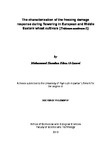The Characterisation of the Freezing Damage Response during Flowering in European and Middle Eastern Wheat Cultivars (Triticum aestivum L)
| dc.contributor.supervisor | Fuller, Michael P | |
| dc.contributor.author | Al-Issawi, Mohammed Hamdan Edan | |
| dc.contributor.other | Faculty of Science and Engineering | en_US |
| dc.date.accessioned | 2013-06-14T08:56:15Z | |
| dc.date.available | 2013-06-14T08:56:15Z | |
| dc.date.issued | 2013 | |
| dc.date.issued | 2013 | |
| dc.identifier | 10207282 | en_US |
| dc.identifier.uri | http://hdl.handle.net/10026.1/1526 | |
| dc.description | Merged with duplicate record (10026.1/1553) on 03.01.2017 by CS (TIS) | |
| dc.description.abstract |
Wheat (Triticum aestivum L.) is occasionally exposed to low temperature during flowering and huge economic losses can occur especially in some key production countries such as Australia. Although it is generally predicted that there will be a rise in global temperature there are still predicted to be risks associated with low temperature for temperate crops. Post head emergence frost damage remains a major constraint to increasing wheat production. Five Iraqi varieties (Abu-Ghariab, Fatah, Sham6, IPA95 and IPA99) were screened for their frost hardiness (LT50). Abu-Ghariab was chosen for further investigations along with the European cv. Claire because the acclimated frost hardiness level in these two varieties (LT50 -8.07 and -8.01°C for Claire and Abu-Ghariab respectively) was found to be significantly lower than the other varieties in this study. Several techniques were employed including REC%, IR thermography and molecular analysis of cold acclimation in order to characterise the frost resistance of those two varieties. REC% revealed that both Claire and Abu-Ghariab could tolerate some freezing when the spikes were just visible (ZCK 51-60) with an acclimation shift of the LT50 of -1.6 and -2.11°C respectively but this was not apparent at later growth stages. Based on molecular analysis, cold acclimation was shown to be activated at ZCK 51-60 in both varieties. Cbf14 was expressed after 8 hours exposure to acclimatising temperatures (4°C) and then declined to a low, but still up-regulated level in both varieties and this led to expression of the COR15a protein. These molecular changes correlated with the frost tolerance recorded at ZCK 51-60. It was concluded that the possibility existed to up-regulate cold acclimation after spike emergence if there was enough environmental stimulus. Molybdenum (Mo) was demonstrated to work synergistically with low temperature in increasing the expression of Cbf14 and COR15a. The European wheat cv. Claire showed a higher capacity (-8.14°C) to be acclimated than Iraqi wheat (-7.40°C) under the effect of both Mo and acclimation temperatures. Mo alone increased the expression of Cbf14 in both varieties but did not increase the frost tolerance. Observations of ice nucleation using an infrared thermography (IR) revealed that supercooling is highly likely in spikes and some spikes avoided frost damage even when the temperature fell to -12°C. It was observed that the proportion of frozen spikes was 22.8% while the remainder supercooled. Spraying plants with distilled water was not effective in facilitating ice nucleation in wheat spikes. Observations also revealed that spikes that did freeze started freezing at temperatures of -4 to -5 °C close to temperature of the putative constitutive frost hardiness of un-acclimated wheat and it is suggested that this may reflect that many laboratory freezing experiments may not actually freeze until -5°C. The anthesis stage of wheat was found to be the most vulnerable stage and it needs to be given more attention in terms of research to up-regulate cold acclimation. Frost damage to wheat during flowering continues to be a serious problem in certain production areas and therefore continued effort in characterising and finding suitable solutions to this are imperative. | en_US |
| dc.description.sponsorship | Ministry of Higher Education and Scientific Research-Iraqi Embassy/Cultural attache-London | en_US |
| dc.language.iso | en | en_US |
| dc.publisher | University of Plymouth | en_US |
| dc.subject | Cold acclimation | |
| dc.subject | CBF Transcription factor | |
| dc.subject | COR15a Protein | |
| dc.subject | Molybdenum | |
| dc.subject | Wheat | en_US |
| dc.title | The Characterisation of the Freezing Damage Response during Flowering in European and Middle Eastern Wheat Cultivars (Triticum aestivum L) | en_US |
| dc.type | Thesis | |
| plymouth.version | Full version | en_US |
| dc.identifier.doi | http://dx.doi.org/10.24382/3974 |
Files in this item
This item appears in the following Collection(s)
-
01 Research Theses Main Collection
Research Theses Main


